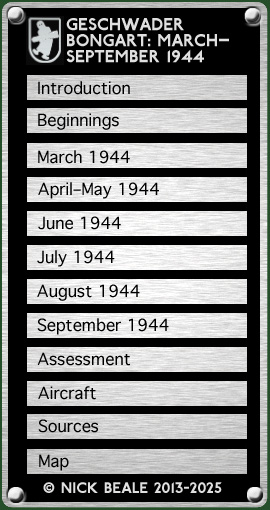|
1-2 June The Auvergne Resistance had mobilised on 20 May and a group about 3,000-strong had gathered on Mont Mouchet, north of Paulhac-en-Margeride. The Germans knew about all this and: The aerial reconaissances [they] carried out enabled them to reconstruct the organisation of the Mont Mouchet redoubt, evaluate its armament and understand its means of supply … On the night of 1/2 June, the men of the 2nd Company were standing guard … the previous day the Mouchard (German spotter plane) had overflown the plateau where the cars and lorries were parked … This was the prelude to a probing attack on 2 June; the main assault would not follow for several days yet From 9./Fl.ZG 2, the three crew of a Ju W. 34 Hi (W.Nr. 2660) were killed at Ettlingen near Karlsruhe: Ofw. Eugen Armbrust (pilot), Ofw. Ernst Rückert (wireless operator) and Stfw. Martin Siegert (flight mechanic). 5 June On the eve of the Allied landings, 7./Fl.ZG 2 lost an aircraft to friendly fire. Oberfeldwebel Walter Lorenz (Re. 2002 W.Nr. 1281) was reported shot down by an Fw 190 near Épernay. There is no corresponding victory claim but the incident took place in the area where the Focke-Wulfs of Stab and I./JG 26 were then based. It is possible that the Reggiane had been mistaken for a “razorback” P-47, a type it superficially resembled. During the morning Fw 190s of 9./SG 4 flew a “special mission” from Valence which may have been against Resistance units active in that area. This was a one-off, the Staffel having returned to Clastres by evening. 6–7 June Hauptmann Heinz Wichelhaus, Kapitän of 11./Fliegerzielgeschwader 2, sent a request for an He 111, CK+PV to be flown over to Châteauroux at once “for Fw. Wielhert.” In response to a series of Maquis actions instigated by a BBC message the night before, German troops arrived in Crest. They were fired on by the Résistants, the fight continuing into the early evening before the insurgents were forced to pull out. The Germans were assisted in this action by a spotter plane. Major Zandt (Kommandeur of the IV. Gruppe) was advised that Oberst Bongart had made an intermediate landing at Orléans-Bricy on the 7th, where his aircraft was damaged by “English fighters” (more likely American ones). Zandt was asked to send a W. 34 to pick up the crew of the damaged machine. The same day, “Kommodore Bongart” signalled from Bourges to Maj. Resch of his 10. Staffel in Aix-Les Milles: this unit was not to transfer but to remain where it was. However, one aircraft with photographic equipment was to be sent at once to Bourges and if any photographic personnel were available they should be sent on in another machine. This reference to the 10. Staffel not transferring suggests that a move had been envisaged, from which it could be inferred that the Invasion was to have triggered a redeployment of the Geschwader’s elements to operational bases. 8 June Gang situation in the Massif Central. It appears that activation of the resistance movements has taken on a greater scope. Counterneasures initiated. Luftflotte 3 morning report On 6 June, the Combat resistance group had briefly seized control of Saint-Amand-Montrond (40 km SSW of Bourges) from the Vichy Milice but pulled out on the evening of the 7th. At around 0500 the next morning the Germans arrived and began “shooting at everything that moved”. They were supported by at least one aircraft, as recalled by an eyewitness interviewed by researcher Philippe Canonne: German soldiers were everywhere. We understood that something special was coming [and] were trying to find a hiding place in our house when we heard an aircraft over the town. It flew over several times at low altitude … [but it] was too low and hit a tree … It crashed an caught fire immediately, no chance for the pilot to escape. M. Canonne has been able to identify the aircraft as Fw 190 A-8 W.Nr. 0234, flown by Fähnrich Johann Köster who died in the crash. The pilot was a member of the Jagdlehrer Überprüfungsgruppe (fighter instructor testing group). This unit had recently left, or was in the process of leaving, Orange-Caritat. Since Kößler was on an operation, he may well have been a member of the Gruppe’s operational component, the Einsatzstaffel. His aircraft however poses a different question: if it was an A-8 (a type usually referred to by a six-digit Werk Nummer) then it did not come from the Überprüfungsgruppe which had never had that recently-introduced model on its strength and did not record any Fw 190 losses during June. It is perhaps possible that the unlucky machine had belonged to Ergänzungsjagdgruppe Süd whose 1. Staffel was likewise based at Caritat. That Gruppe had begun the month with 34 of the A-8 and recorded just one lost — “not through enemy action” — which can however be accounted for by another incident. continued on next page …
|
|||


